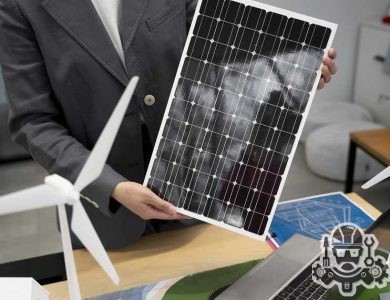The Power of Renewable Energy: Harnessing Nature’s Resources for a Sustainable Future

Contents
What Is Renewable Energy?
Renewable energy refers to the energy that is generated from sources that are naturally replenished. These sources include sunlight, wind, rain, tides, geothermal heat, and biomass. Unlike fossil fuels, which are finite and contribute to environmental degradation, renewable energy is sustainable and has a minimal impact on the environment. It offers an alternative to conventional energy sources, reducing our dependence on non-renewable resources and helping combat climate change.
Renewable energy is harnessed through various technologies and methods. Solar energy, for instance, is captured using photovoltaic panels or solar thermal systems to convert sunlight into electricity or heat. Wind energy is generated by harnessing the power of wind through wind turbines, which then convert it into electricity. Hydroelectric power is derived from moving water, while geothermal energy utilizes heat from beneath the Earth’s surface. Biomass energy involves the combustion or conversion of organic materials such as agricultural residues or wood to produce heat or electricity.
The advantages of renewable energy are numerous. Firstly, it is a clean source of energy that produces little to no greenhouse gas emissions, helping to mitigate climate change. It also reduces air pollution, improving the quality of the air we breathe. Additionally, renewable energy is abundant and widely distributed, offering a more decentralized power generation system. This reduces the reliance on centralized fossil fuel-based power plants and improves energy security. Furthermore, renewable energy sources have the potential to create jobs, stimulate economic growth, and reduce energy costs in the long run.
- Renewable energy offers an alternative to conventional energy sources.
- Renewable energy is harnessed through various technologies and methods.
- The advantages of renewable energy include its clean nature and potential economic benefits.
| Type of Renewable Energy | Main Features |
|---|---|
| Solar Energy | Energy from the sun, captured through photovoltaic panels or solar thermal systems. |
| Wind Energy | Energy from the wind, harnessed through wind turbines. |
| Hydroelectric Power | Energy from moving water, such as rivers or dams. |
| Geothermal Energy | Heat energy from beneath the Earth’s surface. |
| Biomass Energy | Energy derived from organic materials, such as agricultural residues or wood. |
Advantages Of Renewable Energy

Renewable energy is a term that is becoming increasingly common in today’s society. It refers to energy sources that are naturally replenished and have a minimal impact on the environment. These sources include sunlight, wind, rain, tides, waves, and geothermal heat. One of the major advantages of renewable energy is that it is sustainable and can be harnessed without depleting natural resources. This sets it apart from traditional forms of energy generation, which rely on finite resources such as coal, oil, and natural gas.
One of the key benefits of renewable energy is its positive impact on the environment. Unlike fossil fuels, which release harmful greenhouse gases into the atmosphere, renewable energy sources produce little to no emissions. This is crucial in the fight against climate change and global warming. By reducing our reliance on fossil fuels and transitioning to renewable sources, we can significantly reduce carbon dioxide emissions and mitigate the environmental damage caused by traditional energy generation.
Another advantage of renewable energy is its potential to create job opportunities and stimulate economic growth. As the demand for clean and sustainable energy continues to rise, so does the need for skilled workers in the renewable energy sector. According to the International Renewable Energy Agency (IRENA), the renewable energy sector employed approximately 11.5 million people worldwide in 2019. This number is expected to increase in the coming years, offering employment opportunities and contributing to economic development.
- Renewable energy is also a reliable and resilient source of power. Unlike fossil fuels, which are subject to price volatility and supply disruptions, renewable energy sources are abundant and widely available. For example, solar energy can be harnessed in sunny regions, and wind energy is more prevalent in coastal areas. By diversifying our energy mix and harnessing a combination of renewable sources, we can ensure a more stable and secure energy supply.
Furthermore, renewable energy reduces our dependence on imported fossil fuels. Many countries heavily rely on fossil fuel imports to meet their energy needs, which can be costly and politically sensitive. By investing in renewable energy infrastructure and technologies, countries can reduce their reliance on foreign energy sources and enhance energy security. This not only strengthens the domestic energy market but also reduces the vulnerability to geopolitical risks and price fluctuations associated with fossil fuels.
| Advantages | Renewable Energy |
|---|---|
| 1 | Environmentally friendly |
| 2 | Sustainable and abundant |
| 3 | Job creation and economic growth |
| 4 | Reliable and resilient |
| 5 | Reduced dependence on imported fossil fuels |
In conclusion, the advantages of renewable energy are numerous and far-reaching. Not only does it offer a sustainable and environmentally friendly alternative to fossil fuels, but it also promotes economic growth, job creation, and energy security. Investing in renewable energy is not only an investment in a cleaner and brighter future but also a catalyst for positive change in our society. By harnessing the power of renewable sources, we can pave the way for a more sustainable and resilient energy system.
Types Of Renewable Energy Sources

Renewable energy has become increasingly popular in recent years as the world seeks more sustainable and eco-friendly alternatives to traditional sources of energy. The demand for renewable energy sources has grown as people become more aware of the negative impact of fossil fuels on the environment. In this blog post, we will explore the different types of renewable energy sources and their benefits.
One of the most well-known types of renewable energy is solar power. Solar energy harnesses the power of the sun through the use of solar panels. These panels convert sunlight into electricity that can be used to power homes, businesses, and even entire cities. Solar power is an abundant and clean source of energy, making it highly sustainable and environmentally friendly.
Another type of renewable energy is wind power. Wind turbines are used to capture the kinetic energy of the wind and convert it into electricity. This form of energy has been utilized for centuries, but advancements in technology have made wind power even more efficient and cost-effective. Wind farms can be found in various locations around the world, generating electricity for millions of people.
- Hydropower is another significant renewable energy source. It utilizes the kinetic energy of flowing or falling water to generate electricity. Dams and hydroelectric power plants are built to control the flow of water and convert its energy into usable power. Hydropower is a reliable and renewable source of energy, as water is constantly replenished by rainfall or melting ice.
In addition to solar, wind, and hydropower, there are several other types of renewable energy sources that are being explored and developed. Geothermal energy harnesses heat from beneath the Earth’s surface to generate electricity or heat buildings. It relies on the Earth’s natural heat and does not produce emissions or pollution. Biomass energy, on the other hand, involves using organic materials or waste products to generate heat and electricity. This can include agricultural waste, wood pellets, and even human and animal waste.
| Type of Renewable Energy | Description |
|---|---|
| Solar Power | Converts sunlight into electricity using solar panels. |
| Wind Power | Uses the kinetic energy of the wind to generate electricity. |
| Hydropower | Converts the energy of flowing or falling water into electricity. |
| Geothermal Energy | Utilizes heat from beneath the Earth’s surface to generate electricity or heat buildings. |
| Biomass Energy | Uses organic materials or waste products to generate heat and electricity. |
In conclusion, there are various types of renewable energy sources that offer alternative solutions to our energy needs. Solar power, wind power, hydropower, geothermal energy, and biomass energy are just a few examples of sustainable and eco-friendly options. By investing in and promoting the use of renewable energy, we can reduce our carbon footprint, mitigate the effects of climate change, and create a cleaner and brighter future for generations to come.
Importance Of Investing In Renewable Energy
In today’s world, where the effects of climate change are becoming increasingly evident, the importance of investing in renewable energy cannot be overstated. Renewable energy refers to energy sources that are naturally replenished, such as solar power, wind power, hydroelectricity, and geothermal energy. Unlike non-renewable energy sources like fossil fuels, which are finite and contribute to pollution, renewable energy offers a sustainable and clean alternative. Investing in renewable energy not only helps combat climate change but also brings a multitude of other benefits.
One of the key advantages of investing in renewable energy is the reduction in greenhouse gas emissions. Greenhouse gases are a major contributor to global warming, which causes adverse effects on the environment and human health. By replacing the use of fossil fuels with renewable energy sources, such as solar or wind power, we can significantly reduce the emission of greenhouse gases like carbon dioxide and methane. This reduction is vital in mitigating the impacts of climate change and creating a sustainable future for generations to come.
Furthermore, investing in renewable energy promotes energy independence and security. Unlike traditional energy sources, which often rely on imports and fluctuating prices, renewable energy can be generated locally. By harnessing the power of the sun, wind, or water, countries can become less dependent on foreign sources of energy and enhance their energy security. This also reduces the vulnerability to geopolitical tensions and price fluctuations associated with non-renewable energy sources.
- Renewable energy sources also offer economic benefits. The renewable energy sector is a rapidly growing industry, creating numerous job opportunities. Investments in renewable energy technologies not only drive innovation and research but also provide employment opportunities in manufacturing, installation, and maintenance. This not only boosts local economies but also supports the transition towards a more sustainable future.
- Moreover, investing in renewable energy diversifies the energy mix. Relying solely on fossil fuels for energy production puts us at risk of supply disruptions and price volatility. By diversifying our energy sources and incorporating renewables, we can create a more stable and resilient energy system. This also reduces our dependence on non-renewable resources and opens up opportunities for sustainable development.
- Lastly, investing in renewable energy helps to preserve natural resources and protect ecosystems. Extracting and burning fossil fuels contribute to air and water pollution, disrupt ecosystems, and cause habitat destruction. Renewable energy, on the other hand, has minimal impact on the environment and does not deplete natural resources. By investing in renewable energy, we can minimize these harmful effects and preserve the beauty and biodiversity of our planet.
In conclusion, the importance of investing in renewable energy cannot be overstated. It is not only essential for combating climate change and reducing greenhouse gas emissions but also offers economic, social, and environmental benefits. By promoting energy independence, creating job opportunities, diversifying the energy mix, and preserving natural resources, renewable energy paves the way for a sustainable and resilient future. As individuals, businesses, and governments, we must recognize the significance of investing in renewable energy and work towards a clean and sustainable energy revolution.
| Advantages of Investing in Renewable Energy | Importance of Investing in Renewable Energy | Types of Renewable Energy Sources |
|---|---|---|
| – Reduction in greenhouse gas emissions | – Energy independence and security | – Solar power |
| – Economic benefits and job creation | – Diversification of the energy mix | – Wind power |
| – Preservation of natural resources and ecosystems | – Environmental sustainability | – Hydroelectricity |
| – Geothermal energy |
Challenges In Implementing Renewable Energy
Implementing renewable energy sources can bring about a variety of challenges and obstacles that need to be overcome in order to fully realize the benefits of clean and sustainable power. One of the primary challenges is the initial cost associated with setting up renewable energy infrastructure. The installation and maintenance of solar panels, wind turbines, and other renewable energy technologies often require significant upfront investment. However, it is important to note that although the initial costs may be high, the long-term operational costs of renewable energy systems are relatively low.
Another challenge in implementing renewable energy is the intermittent nature of certain renewable resources. Unlike traditional fossil fuel power plants that can operate around the clock, renewable energy sources such as solar and wind power are dependent on environmental conditions. The availability of these resources fluctuates throughout the day and is influenced by weather patterns. Consequently, energy storage technologies, such as batteries, are essential to store excess energy generated during peak times for use during periods of low generation.
Additionally, the lack of a well-developed and efficient grid infrastructure can be a major obstacle in implementing renewable energy sources. In order to effectively integrate renewable power into the existing electricity grid, upgrades and improvements to the transmission and distribution systems are necessary. This is particularly important when considering the potential for renewable energy sources to be spread over a wide geographical area, such as wind farms located offshore or solar installations in remote locations.
- Renewable energy infrastructure: The installation and maintenance of renewable energy technologies often require significant upfront investment.
Impact Of Renewable Energy On The Environment
Renewable energy, often referred to as clean energy, is becoming increasingly important in the fight against climate change and the preservation of our environment. The impact of renewable energy on the environment is profound, as it offers significant advantages over traditional fossil fuel-based energy sources. By utilizing renewable energy technologies, we can reduce greenhouse gas emissions, improve air and water quality, and mitigate the negative effects of climate change.
One of the key advantages of renewable energy is that it produces little to no greenhouse gas emissions during operation. Unlike fossil fuel power plants, which release carbon dioxide and other harmful pollutants into the atmosphere when burned, renewable energy sources such as solar, wind, hydro, and geothermal power generate electricity without producing any greenhouse gases. This reduction in emissions helps to combat climate change by limiting the amount of heat-trapping gases in the atmosphere, thus reducing the overall global warming effect.
Furthermore, renewable energy sources have a minimal impact on local ecosystems and natural resources. Unlike fossil fuels, which require extensive mining and drilling operations, renewable energy technologies can be built with minimal disruption to the environment. For instance, solar panels can be installed on rooftops or in open fields, wind turbines can be erected in agrarian areas or offshore, and hydropower plants can be built without causing significant damage to rivers and streams. This allows us to preserve natural habitats, protect biodiversity, and maintain the delicate balance of ecosystems.
- In addition to these environmental benefits, renewable energy also has positive economic impacts. The transition to renewable energy sources creates jobs, stimulates economic growth, and increases energy independence. As renewable energy industries expand, they create employment opportunities in manufacturing, installation, maintenance, and research. Moreover, investing in renewable energy can reduce our dependence on fossil fuel imports and create a more sustainable and resilient energy system. This helps to stabilize energy prices and improve energy security for both individuals and nations.
| Type of Renewable Energy | Main Advantages |
|---|---|
| Solar Energy | – Abundant and freely available – Low operating costs – Scalable for different energy needs |
| Wind Energy | – No greenhouse gas emissions – Cost-effective in suitable locations – Allows for localized power generation |
| Hydropower | – Reliable and predictable – Long lifespan – Provide flood control and irrigation |
| Geothermal Energy | – Renewable and sustainable – Low operating costs – Utilizable in various settings |
In conclusion, the impact of renewable energy on the environment cannot be overstated. By harnessing renewable resources such as solar, wind, hydro, and geothermal energy, we can significantly reduce greenhouse gas emissions, protect natural habitats, and create a more sustainable future. The advantages of renewable energy extend beyond environmental benefits, with positive economic impacts and improved energy security. As we continue to invest in and implement renewable energy technologies, we move closer towards a cleaner, greener, and more sustainable planet for generations to come.
Future Of Renewable Energy
The future of renewable energy is bright and promising. As the world becomes more aware of the impact of fossil fuels on climate change, there is a growing demand for alternative sources of energy that are cleaner, more sustainable, and renewable. Renewable energy refers to energy sources that are naturally replenished, such as sunlight, wind, water, geothermal heat, and biomass. These sources of energy have the potential to revolutionize the way we generate power, reduce our carbon footprint, and create a more sustainable future for generations to come.
One of the key advantages of renewable energy is its abundant availability. Unlike fossil fuels, which are finite resources and will eventually run out, renewable energy sources are constantly replenished by nature. The sun will continue to shine, the wind will continue to blow, and water will continue to flow. This means that as long as we have access to these natural resources, we will have a reliable and sustainable source of energy. Additionally, renewable energy sources have the potential to create new job opportunities and stimulate economic growth. Investing in renewable energy can help to create a green economy and promote sustainable development.
There are several types of renewable energy sources that are currently being harnessed and developed. Solar energy is perhaps one of the most well-known and widely used forms of renewable energy. Solar panels convert sunlight into electricity, providing a clean and sustainable source of power. Wind energy is another popular form of renewable energy, with wind turbines harnessing the power of the wind to generate electricity. Hydropower utilizes the force of flowing or falling water to generate electricity, while geothermal energy taps into the heat beneath the Earth’s surface. Biomass, derived from organic matter such as plants and agricultural waste, can also be converted into energy. These various types of renewable energy sources provide diverse options for reducing our reliance on fossil fuels and transitioning to a greener future.
| Advantages of Renewable Energy |
|---|
| Renewable energy sources are abundant and sustainable. |
| They can create job opportunities and stimulate economic growth. |
| Solar energy, wind energy, hydropower, geothermal energy, and biomass are examples of renewable energy sources. |
Renewable energy is energy that is collected from renewable resources, such as sunlight, wind, rain, tides, and geothermal heat. These sources are replenished naturally and have a lower impact on the environment compared to non-renewable sources like fossil fuels.
Renewable energy has several advantages. It helps reduce greenhouse gas emissions, promotes energy independence, creates job opportunities, and enhances energy security. It also mitigates the effects of climate change and fosters sustainable development.
There are various types of renewable energy sources. These include solar energy, wind energy, hydroelectric power, biomass, and geothermal energy. Each source harnesses nature's power in a different way to generate clean and sustainable energy.
Investing in renewable energy is crucial for several reasons. It reduces dependence on fossil fuels, decreases pollution and greenhouse gas emissions, and helps mitigate climate change. Additionally, it fosters innovation, creates job opportunities, and promotes a more sustainable and secure energy future.
Implementing renewable energy faces some challenges. These include high initial costs, limited storage capacity, intermittency issues for certain sources, and the need for extensive transmission infrastructure. Overcoming these challenges requires technological advancements, policy support, and investment in research and development.
Renewable energy has a positive impact on the environment. It reduces carbon dioxide emissions, air pollution, and the release of harmful chemicals. It also helps preserve natural resources, protects ecosystems, and contributes to the overall health and well-being of the planet.



